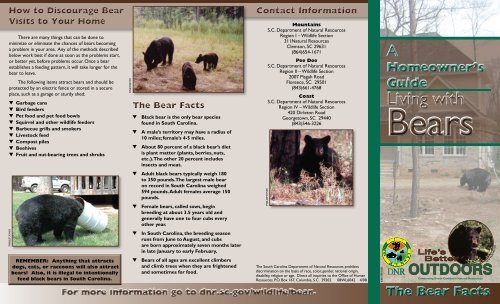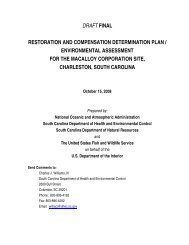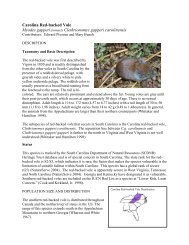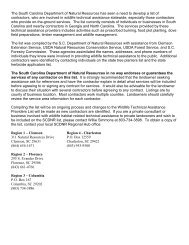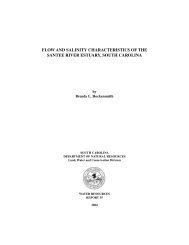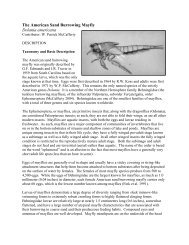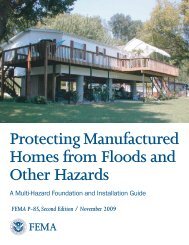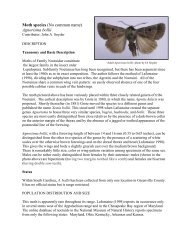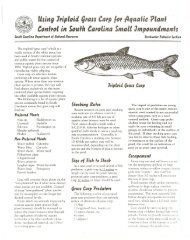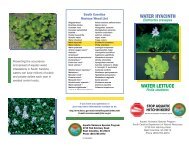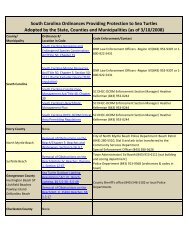Homeowner's Guide - South Carolina Department of Natural ...
Homeowner's Guide - South Carolina Department of Natural ...
Homeowner's Guide - South Carolina Department of Natural ...
Create successful ePaper yourself
Turn your PDF publications into a flip-book with our unique Google optimized e-Paper software.
How to Discourage Bear<br />
Visits to Your Home<br />
There are many things that can be done to<br />
minimize or eliminate the chances <strong>of</strong> bears becoming<br />
a problem in your area. Any <strong>of</strong> the methods described<br />
below work best if done as soon as the problems start,<br />
or better yet, before problems occur. Once a bear<br />
establishes a feeding pattern, it will take longer for the<br />
bear to leave.<br />
The following items attract bears and should be<br />
protected by an electric fence or stored in a secure<br />
place, such as a garage or sturdy shed:<br />
t Garbage cans<br />
t Bird feeders<br />
t Pet food and pet food bowls<br />
t Squirrel and other wildlife feeders<br />
t Barbecue grills and smokers<br />
t Livestock feed<br />
t Compost piles<br />
t Beehives<br />
t Fruit and nut-bearing trees and shrubs<br />
phillip jones<br />
REMEMBER: Anything that attracts<br />
dogs, cats, or raccoons will also attract<br />
bears! Also, it is illegal to intentionally<br />
feed black bears in <strong>South</strong> <strong>Carolina</strong>.<br />
DnR Photo<br />
The Bear Facts<br />
t Black bear is the only bear species<br />
found in <strong>South</strong> <strong>Carolina</strong>.<br />
t A male’s territory may have a radius <strong>of</strong><br />
10 miles; female’s 4-5 miles.<br />
t About 80 percent <strong>of</strong> a black bear’s diet<br />
is plant matter (plants, berries, nuts,<br />
etc.). The other 20 percent includes<br />
insects and meat.<br />
t Adult black bears typically weigh 180<br />
to 350 pounds. The largest male bear<br />
on record in <strong>South</strong> <strong>Carolina</strong> weighed<br />
594 pounds. Adult females average 150<br />
pounds.<br />
t Female bears, called sows, begin<br />
breeding at about 3.5 years old and<br />
generally have one to four cubs every<br />
other year.<br />
t In <strong>South</strong> <strong>Carolina</strong>, the breeding season<br />
runs from June to August, and cubs<br />
are born approximately seven months later<br />
in late January to early February.<br />
t Bears <strong>of</strong> all ages are excellent climbers<br />
and climb trees when they are frightened<br />
and sometimes for food.<br />
Contact Information<br />
Mountains<br />
S.C. <strong>Department</strong> <strong>of</strong> <strong>Natural</strong> Resources<br />
Region I – Wildlife Section<br />
311<strong>Natural</strong> Resources<br />
Clemson, SC 29631<br />
(864)654-1671<br />
Pee Dee<br />
S.C. <strong>Department</strong> <strong>of</strong> <strong>Natural</strong> Resources<br />
Region II – Wildlife Section<br />
2007 Pisgah Road<br />
Florence, SC 29501<br />
(843)661-4768<br />
Coast<br />
S.C. <strong>Department</strong> <strong>of</strong> <strong>Natural</strong> Resources<br />
Region IV – Wildlife Section<br />
420 Dirleton Road<br />
Georgetown, SC 29440<br />
(843)546-3226<br />
The <strong>South</strong> <strong>Carolina</strong> <strong>Department</strong> <strong>of</strong> <strong>Natural</strong> Resources prohibits<br />
discrimination on the basis <strong>of</strong> race, color, gender, national origin,<br />
disabiltiy, religion or age. Direct all inquiries to the Office <strong>of</strong> Human<br />
Resources, P.O. Box 167, Columbia, S.C. 29202. 08WL6042 4/08<br />
For more information go to dnr.sc.gov/wildlife/bear.<br />
phillip jones<br />
kristin Gill<br />
A<br />
Homeowner’s<br />
<strong>Guide</strong><br />
Living with<br />
Bears<br />
The Bear Facts<br />
SCW flie photo
Be Bear Safe at Home…<br />
<strong>South</strong> <strong>Carolina</strong> residents, should know…<br />
If you encounter a bear at<br />
close range, remain standing<br />
upright, avoid direct eye contact,<br />
back up slowly and speak in a<br />
calm, assertive, assuring voice.<br />
Make yourself look as big as<br />
possible by waving arms, etc. Do<br />
not run from the bear or climb<br />
a tree. If the bear continues to<br />
come closer, talk in a more aggressive tone. As a last<br />
resort throw rocks or limbs and try to fight back.<br />
Bears naturally investigate food odors and are<br />
attracted to many different foods such as garbage,<br />
birdseed and suet, pet foods, compost piles, and grease<br />
on barbecue grills. Once a bear receives a “reward” such<br />
as one <strong>of</strong> these foods, it may return to the same area<br />
several times (even after food is removed) or search<br />
around the general area for similar foods. The solution<br />
to most bear problems is to remove the attraction<br />
before conflicts occur. In <strong>South</strong> <strong>Carolina</strong>, it is illegal to<br />
entice bears by any means. The law states that you must<br />
take away the attractants when bears are coming to<br />
your yard.<br />
No feeding – Don’t feed a bear and it will likely leave<br />
the area. A bear accustomed to having food provided is<br />
an accident waiting to happen.<br />
No garbage – Keep garbage in a tightly shut or bearpro<strong>of</strong><br />
trash can/dumpster. Garbage left in the open or in<br />
a vehicle can attract bears. Bears have a good sense <strong>of</strong><br />
smell and may pry into your trunk or truck cab for food.<br />
Putting a cup <strong>of</strong> ammonia in the bottom <strong>of</strong> garbage cans<br />
helps to deter bears and other animals.<br />
Pet food storage – If stored outside, put pet food<br />
in airtight storage containers and don’t leave leftover<br />
food out in the open.<br />
Clean grills – Keep charcoal and gas grills covered<br />
and clean to keep food odors from attracting bears.<br />
Bird feed & feeders – There is a chance bears<br />
may get into your bird feeders. If bears get into the<br />
feeders, remove the feeders for awhile. Once the feeder<br />
is gone the bear will move on.<br />
phillip jones<br />
Deer stands – If you live in a region <strong>of</strong> the state<br />
where deer baiting is allowed, you may need to stop<br />
baiting your stand for a few weeks to ensure the bear<br />
will move on.<br />
Beehives – Beehives in bear territory should<br />
be protected with a bear pro<strong>of</strong> electric fence. Your<br />
investment will be minimal compared to the costs <strong>of</strong><br />
your hives.<br />
When a bear is up in a tree, keep people and<br />
pets away. Eventually, when things quiet down,<br />
the bear will come down and leave. This usually<br />
happens after dark when the bear feels safe.<br />
Did you know?<br />
t As both bear and human populations<br />
increase and expand, more encounters will<br />
occur. In other states, bear have learned to<br />
survive in heavily human populated areas.<br />
t When a bear stands on its hind legs, it is<br />
trying to get a better view. It is not trying to<br />
be threatening.<br />
t A bear may huff, snap its jaws and swat the<br />
ground. This behavior means the bear is<br />
uncomfortable and you are too close. Slowly<br />
back away. Do not run.<br />
t Black bears will sometimes “bluff charge”<br />
when they are cornered, feel threatened,<br />
or when they are attempting to steal food.<br />
Stand your ground and then slowly back<br />
away.<br />
t Contrary to popular belief, female black<br />
bears typically do not aggressively defend<br />
cubs against humans.<br />
t Black bears are not generally aggressive,<br />
even when confronted by humans. However,<br />
they are large, powerful, wild animals that<br />
need to be respected. No injuries or deaths<br />
have been attributed to black bears in <strong>South</strong><br />
<strong>Carolina</strong>.<br />
t In SC, 35 bears are killed by vehicles<br />
annually. The majority <strong>of</strong> deaths occur in<br />
Horry County.<br />
Black bears once roamed the entire state <strong>of</strong> <strong>South</strong><br />
<strong>Carolina</strong>. Today there are two resident bear populations,<br />
one in the mountains/upper piedmont and in the northern<br />
coastal counties, but the ranges <strong>of</strong> both populations are<br />
expanding. As the human population increases and<br />
development encroaches on bear habitat, encounters<br />
between bears and humans have become more frequent.<br />
In fact, calls to the S.C. <strong>Department</strong> <strong>of</strong> <strong>Natural</strong><br />
Resources (DNR) about black bear encounters have<br />
increased from 20 in 1990 to over 450 in recent years.<br />
Often these calls involve bears that have been fed by<br />
humans, either intentionally or unintentionally.<br />
The mere presence <strong>of</strong> a black bear does not<br />
necessarily represent a problem. In fact, living in bear<br />
country can provide some unique and rewarding<br />
experiences for residents.<br />
Most bear problems in residential areas are<br />
temporary and usually occur in the spring, summer, and<br />
late fall months. Between the time bears emerge from<br />
their dens and summer foods such as berries ripen,<br />
natural food supplies are low and not very nutritious.<br />
This causes bears to travel more in search <strong>of</strong> food.<br />
Also, breeding season occurs from June to August, and<br />
male bears tend to roam in search <strong>of</strong> mates. During<br />
the same time period, young males are dispersing to<br />
new territories and <strong>of</strong>ten wander into residential areas.<br />
Finally, late fall marks the time when bears are searching<br />
for food to create fat stores to last them through the<br />
winter. By keeping food away from bears during those<br />
times <strong>of</strong> increased travel, many problems may be avoided.<br />
For more information go to dnr.sc.gov/wildlife/bear.<br />
phillip jones<br />
Skip Still<br />
People <strong>of</strong>ten ask why problem bears can’t simply<br />
be relocated. There are several reasons why moving<br />
problem bears is not an option. First and foremost,<br />
moving a bear does not address the problem. If the<br />
problem is not fixed, other bears will move in to take<br />
advantage <strong>of</strong> the food source, or the bear that was<br />
moved away may return and become a problem once<br />
more. Second, catching a wild animal such as a bear puts<br />
both the bear and people at risk <strong>of</strong> injury. Third, most<br />
people wish to keep bears as a viable species in <strong>South</strong><br />
<strong>Carolina</strong>, and if bear and humans are going to coexist,<br />
human attitudes and habits must change. Finally, there<br />
are no longer areas that are sufficiently remote enough<br />
to ensure that a relocated bear will not encounter other<br />
residences and possibly become a nuisance there.<br />
Black bears are an important part <strong>of</strong> <strong>South</strong> <strong>Carolina</strong>’s<br />
fauna. DNR is committed to ensuring the long-term well<br />
being <strong>of</strong> the black bear, while addressing the property<br />
damage and safety concerns <strong>of</strong> residents. Wildlife<br />
biologists can provide technical advice to residents who<br />
live in bear country to help them take actions that will<br />
discourage bears from becoming a nuisance.<br />
The key to coexisting with bears is understanding and<br />
respecting them, and following the rules and regulations<br />
aimed to protect the public and bears.


